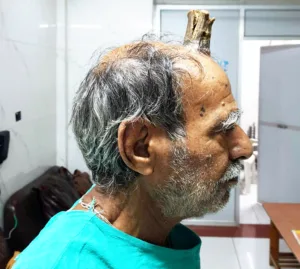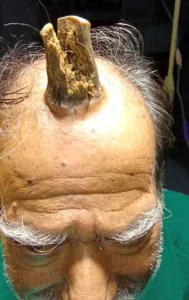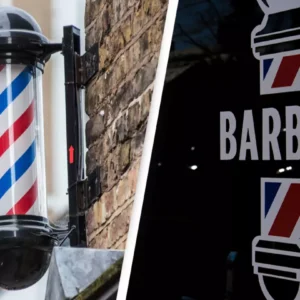In India, a man underwent surgery to remove a large, horn-like growth from the top of his head, which had developed over several years.
The Growth
Back in 2014, Shyam Lal Yadav suffered a head injury and soon noticed a small growth emerging from his scalp. Initially, the growth didn’t bother him much. He simply had it trimmed by his barber since it wasn’t causing any pain or discomfort. However, as time passed, the situation became more concerning for the 74-year-old when the growth began to harden and take on the shape of a horn.

Seeking Medical Help
Realizing the seriousness of the situation, Shyam, who hails from Madhya Pradesh in central India, decided to consult medical professionals. Doctors identified the growth as a sebaceous horn. This type of growth is made up of compacted keratin, the same material that makes up our hair, nails, and skin. Keratin is also found in nature, forming parts of animals like rhino horns, bird feathers, and beaks.
Understanding Sebaceous Horns
The exact causes of such growths in humans are not clearly understood. However, they are more commonly seen in older individuals and typically appear on parts of the body that get a lot of sun exposure, like the head or shoulders.

The Surgery
This particular case was handled by Surgeon Dr. Vishal Gajbhiye at Bhagyoday Tirth Hospital in Sagar, Madhya Pradesh. Dr. Gajbhiye shared his insights:
“About five years ago, the patient hurt his head, after which a lump started growing. Initially, he ignored it as it did not cause any discomfort and had it cut by the local barber. But when the lump hardened and started growing further, he approached the hospital in Sagar. In medical terms, this type of rare growth is called a sebaceous horn (or devil’s horn). As the horn is composed of keratin, the same material found in fingernails, it can usually be removed with a sterile razor. However, the underlying condition will still need to be treated.”
Post-Surgery and Recovery
Although the growth can be removed, it might also suggest the presence of a malignant tumor in the body. Dr. Gajbhiye further explained:
“Sebaceous horns are predominantly benign lesions; however, the possibility of malignant potential should always be considered. Treatments vary but can include surgery, radiation therapy, and chemotherapy. Immediately after its removal, skin was grafted onto the wound, which has now healed completely.”
After the removal surgery, Shyam spent ten days in the hospital recovering. A biopsy conducted on the removed growth confirmed it was harmless.
Conclusion
Such unusual growths are quite rare, and this particular case was documented and sent to the International Journal of Surgery.





